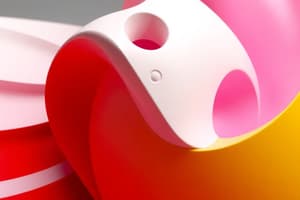Podcast
Questions and Answers
What are the four possible scenarios for the future of 3D printing?
What are the four possible scenarios for the future of 3D printing?
- A) Home factories, B) Print shops, C) Fab labs, D) The 3D museum (correct)
- A) Home factories, B) Print shops, C) Fab labs, D) The 3D zoo
- A) Home factories, B) Print shops, C) Fab labs, D) The 3D circus
- A) Home factories, B) Print shops, C) Fab labs, D) The 3D amusement park
What is the fab labs scenario?
What is the fab labs scenario?
- The market bubble has burst as inflated expectations have caused 3D printing to be severely over-hyped
- Groups of people work together on not-for-profit or subsidised printers to craft objects they intend to use for recreation or for trading and selling in specialist 'maker fairs' (correct)
- Manufacturing has 'returned' to places such as the UK, the US, and Australia, and companies are integrating high-end 3D printers into their supply chains and retail outlets
- Everyone has a 3D printer in their home and is printing much more 'stuff,' mostly made of plastic or resin
What is 3D printing?
What is 3D printing?
- A process that turns virtual reality designs into physical objects from a range of materials and on a range of scales
- A process that turns physical objects into virtual reality designs from a range of materials and on a range of scales
- A process that turns physical objects into computer-aided designs from a range of materials and on a range of scales
- A process that turns computer-aided designs into physical objects from a range of materials and on a range of scales (correct)
What is the main purpose of the article?
What is the main purpose of the article?
What is the 3D bubble scenario?
What is the 3D bubble scenario?
What is the difference between the home factories and the fab labs scenarios?
What is the difference between the home factories and the fab labs scenarios?
Flashcards are hidden until you start studying
Study Notes
The Social Impact of 3D Printing: Four Possible Scenarios for the Future
- 3D printing, or additive manufacturing, turns computer-aided designs into physical objects from a range of materials and on a range of scales.
- Lancaster University and the University of Wollongong have identified four potential scenarios for the social impact of 3D printing.
- At the 3D Printshow 2012 in London, artists, entrepreneurs, and researchers showcased the potential of 3D printing technology, including children creating 3D designs within the game Minecraft.
- The four possible scenarios for the future of 3D printing include: (A) home factories, (B) print shops, (C) fab labs, and (D) the 3D bubble.
- In the home factories scenario, everyone has a 3D printer in their home and is printing much more "stuff," mostly made of plastic or resin.
- In the print shops scenario, manufacturing has "returned" to places such as the UK, the US, and Australia, and companies are integrating high-end 3D printers into their supply chains and retail outlets.
- In the fab labs scenario, groups of people work together on not-for-profit or subsidised printers to craft objects they intend to use for recreation or for trading and selling in specialist "maker fairs."
- In the 3D bubble scenario, the market bubble has burst as inflated expectations have caused 3D printing to be severely over-hyped.
- The potential social impacts of 3D printing need to be discussed now, before the future arrives.
- The 3D Printshow 2012 demonstrated the exciting and inspiring uses of 3D printing technology, including a scale model of the Urbee 3D-printed car and a row of 3D-printed mummified animals from an archaeological project rendered in near-perfect detail.
- The four possible scenarios for the future of 3D printing were shaped by how corporate this new industrial revolution will be and how much individuals will engage with the technology.
- The four possible scenarios for the future of 3D printing offer different implications for the transportation of objects and the travel of people, as well as efficiency gains in how objects are transported and where they are made.
The Social Impact of 3D Printing: Four Possible Scenarios for the Future
- 3D printing, or additive manufacturing, turns computer-aided designs into physical objects from a range of materials and on a range of scales.
- Lancaster University and the University of Wollongong have identified four potential scenarios for the social impact of 3D printing.
- At the 3D Printshow 2012 in London, artists, entrepreneurs, and researchers showcased the potential of 3D printing technology, including children creating 3D designs within the game Minecraft.
- The four possible scenarios for the future of 3D printing include: (A) home factories, (B) print shops, (C) fab labs, and (D) the 3D bubble.
- In the home factories scenario, everyone has a 3D printer in their home and is printing much more "stuff," mostly made of plastic or resin.
- In the print shops scenario, manufacturing has "returned" to places such as the UK, the US, and Australia, and companies are integrating high-end 3D printers into their supply chains and retail outlets.
- In the fab labs scenario, groups of people work together on not-for-profit or subsidised printers to craft objects they intend to use for recreation or for trading and selling in specialist "maker fairs."
- In the 3D bubble scenario, the market bubble has burst as inflated expectations have caused 3D printing to be severely over-hyped.
- The potential social impacts of 3D printing need to be discussed now, before the future arrives.
- The 3D Printshow 2012 demonstrated the exciting and inspiring uses of 3D printing technology, including a scale model of the Urbee 3D-printed car and a row of 3D-printed mummified animals from an archaeological project rendered in near-perfect detail.
- The four possible scenarios for the future of 3D printing were shaped by how corporate this new industrial revolution will be and how much individuals will engage with the technology.
- The four possible scenarios for the future of 3D printing offer different implications for the transportation of objects and the travel of people, as well as efficiency gains in how objects are transported and where they are made.
Studying That Suits You
Use AI to generate personalized quizzes and flashcards to suit your learning preferences.




